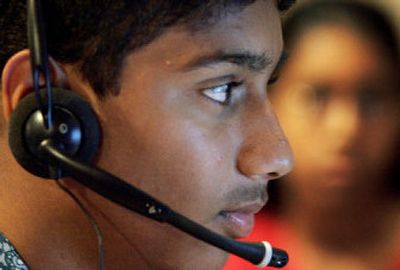The latest in global outsourcing: tutoring American students online

COCHIN, India – A few stars are still twinkling in the inky pre-dawn sky when Koyampurath Namitha arrives for work in a quiet suburb of this south Indian city. It’s barely 4:30 a.m. when she grabs a cup of coffee and joins more than two dozen colleagues, each settling into a cubicle with a computer and earphones.
More than 7,000 miles away, in Glenview, Ill., outside Chicago, it’s the evening of the previous day and 14-year-old Princeton John sits at his computer, barefoot and ready for his hourlong geometry lesson. The high school freshman puts on a headset with a microphone and clicks on computer software that will link him through the Internet to his tutor, Namitha, many time zones away.
It’s called e-tutoring – yet another example of how modern communications, and an abundance of educated, low-wage Asians, are broadening the boundaries of outsourcing and working their way into the minutiae of American life, from replacing your lost credit card through reading your CAT scan to helping you revive your crashed computer.
Princeton is one of thousands of U.S. high school students turning to tutors in India.
“Hello Princeton, how are you? How was your test?” Namitha asks.
“Hello, yeah … I’m good,” Princeton replies. “It was good.”
Namitha works for a company called Growing Stars, based in Cochin and Fremont, Calif. Princeton and his 12-year-old sister Priscilla each meet with their online math teacher twice a week.
The chitchat ends quickly and a geometry worksheet pops up on Princeton’s computer screen.
Teacher and pupil speak to one another, type messages and use digital “pencils” to work on problems, highlight graphs and erase mistakes. Princeton scrawls on something that looks like a hyped-up mouse pad and it shows up on Namitha’s screen. He can also use a scanner to send copies of assignments or textbook pages that he needs help understanding.
“Here we go,” Princeton says, as they begin a lesson on such concepts as parallel lines and complementary angles in the quiet coziness of the family’s suburban home. Above him, on the desk, sit plastic figurines of Mickey and Minnie Mouse and the Statue of Liberty. On the walls are framed photos of his family, including his grandparents who – by coincidence – live in southern India.
His mom, Bessy, brings him orange juice and cookies.
“India has very good teachers, especially in math and science. Also, these subjects are culture-free so it is comparatively easy for Indian teachers to teach them,” says Kiran Karnik, who heads India’s National Association of Software and Service Companies. “Online tutoring is an area which shows enormous potential for growth.”
Most companies are reluctant to talk about earnings. But Shantanu Prakash, chief executive of India-based Educomp Datamatics, estimates that Indian online tutoring companies earned about $10 million last year, 80 percent of it from the United States.
That’s small change in the Indian information technology industry – a business built largely on the outsourcing that is shifting jobs from the West to cheaper, foreign locations. Annual export revenue from offshore outsourcing last fiscal year totaled $17.2 billion.
But about a dozen Indian software firms are banking that online tutoring will flourish in America, where falling standards are causing concern.
The first e-tutoring businesses started less than three years ago, and already thousands of Indian teachers coach U.S. students in math, science or English for about $15-$20 an hour, a fraction of the $40-$100 that private tutoring costs in the United States.
The Indian firms have benefited from the growing U.S. government-financed tutoring industry – which had revenues last year of nearly $2 billion. That growth is partly due to the No Child Left Behind law, which requires schools to test students in math and reading every year from third grade through eighth grade.